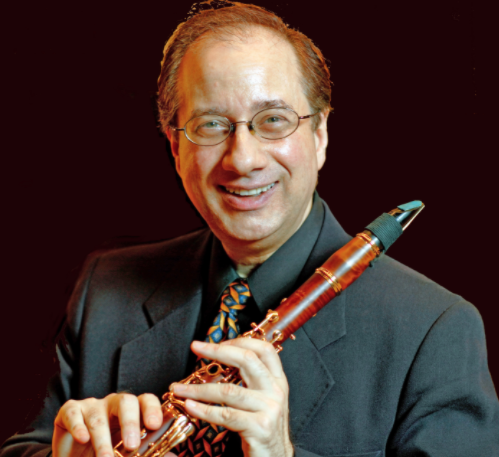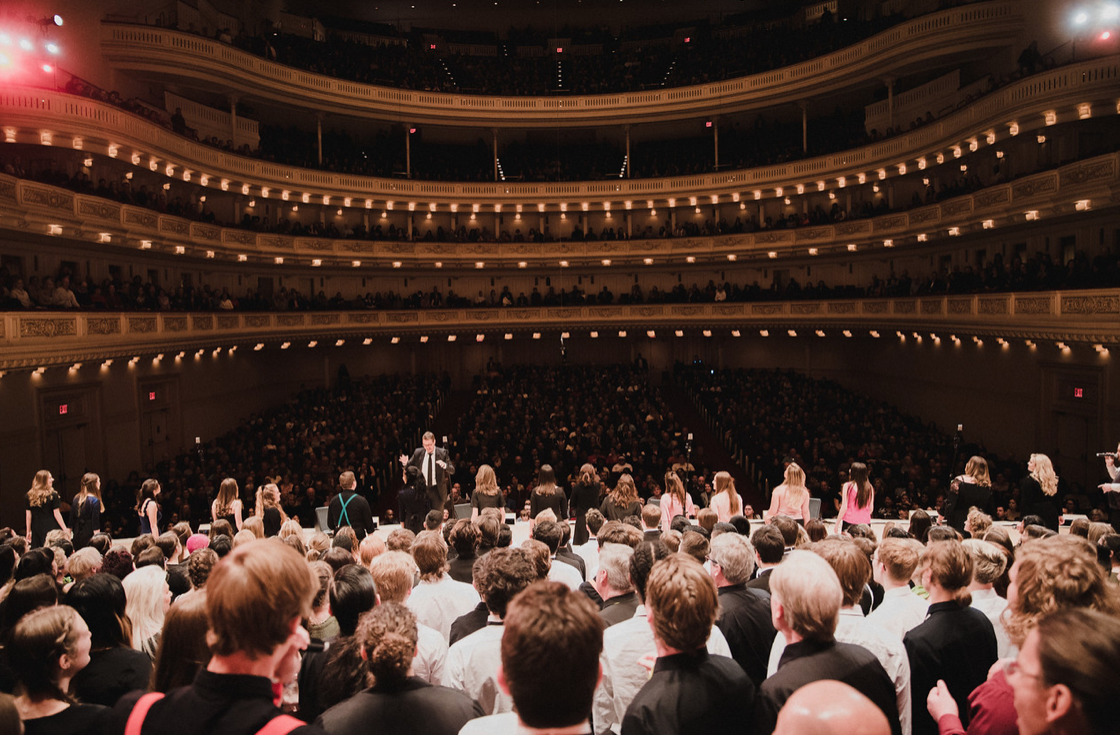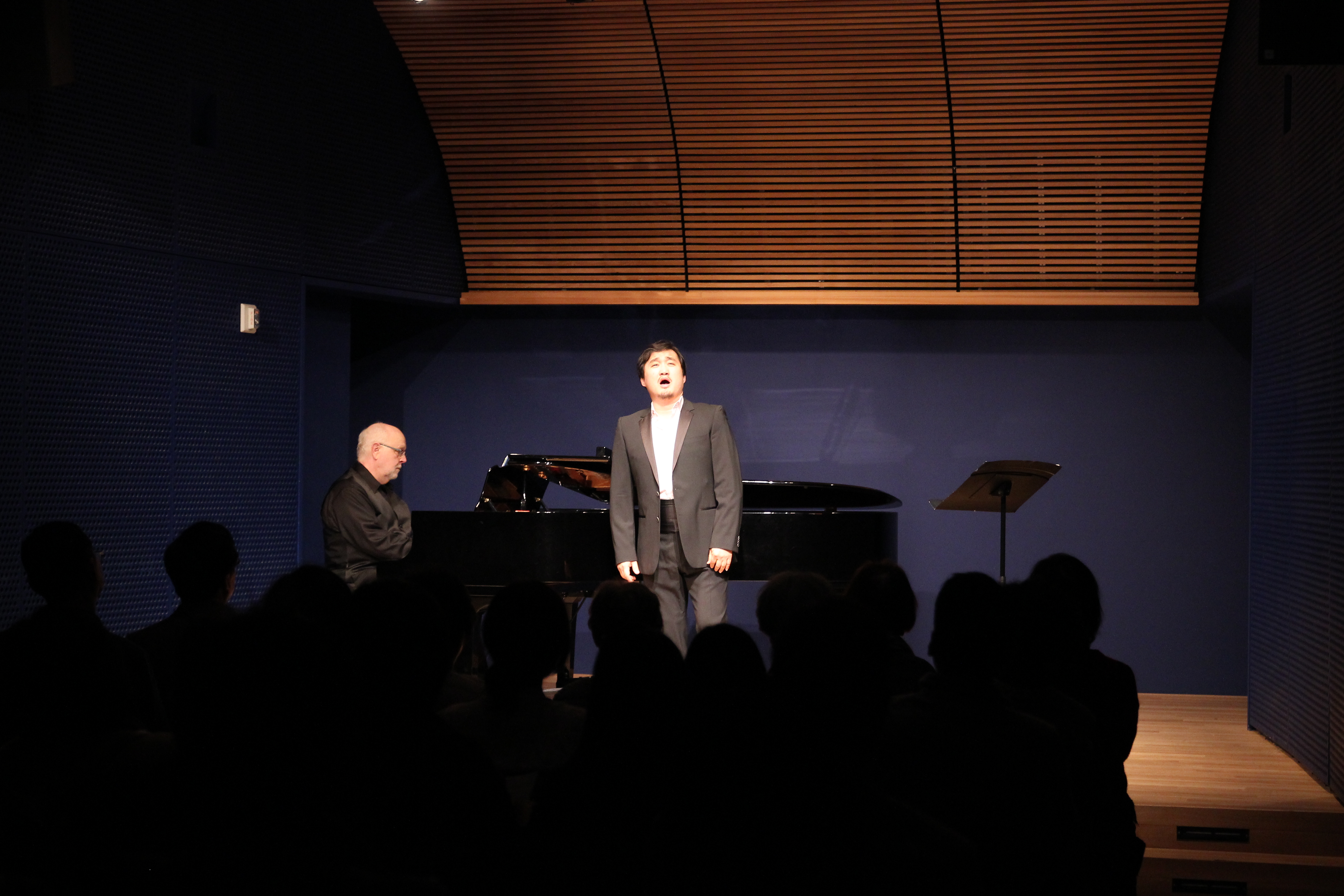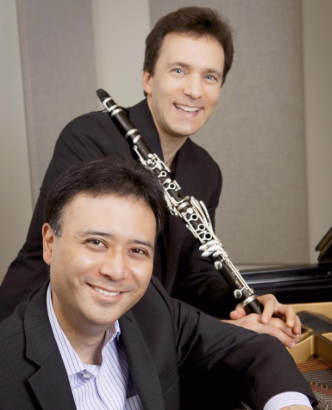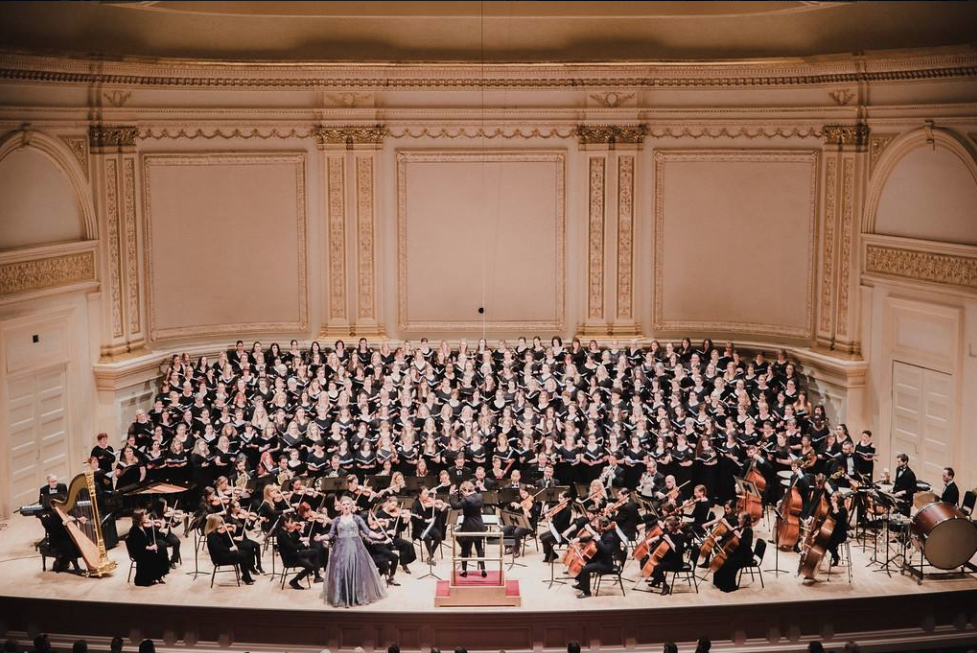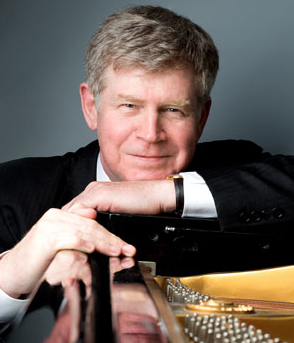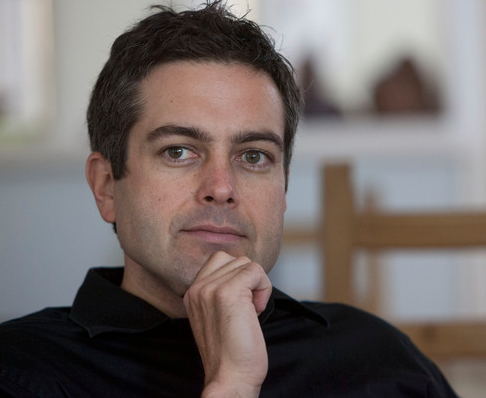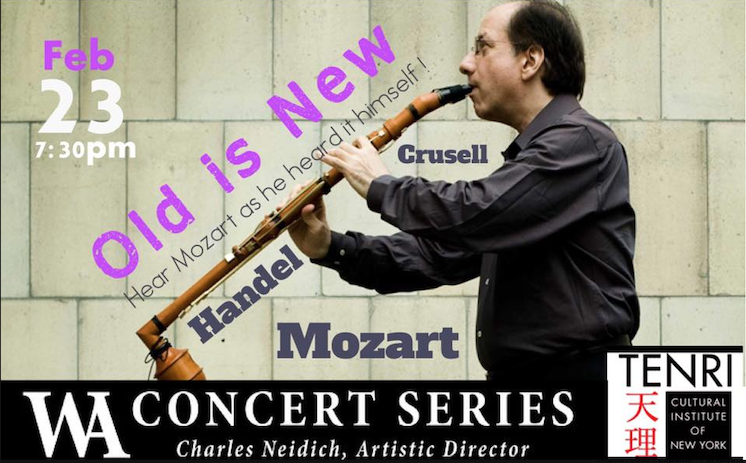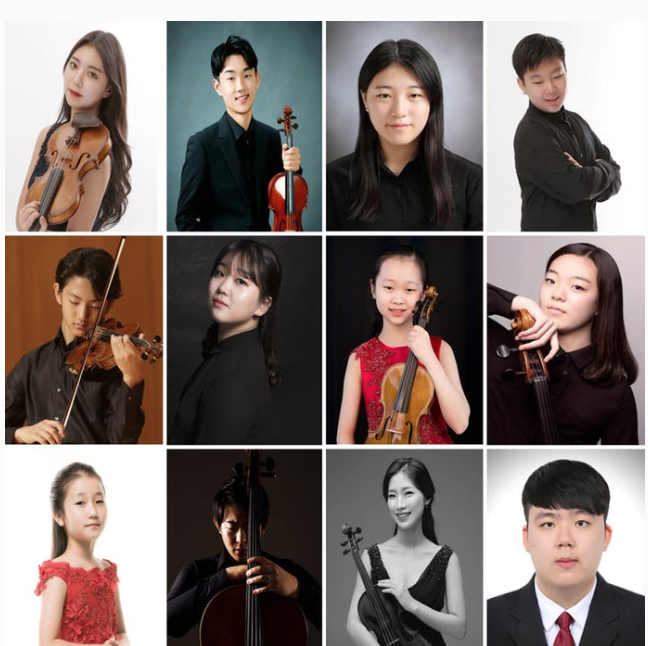Deke Sharon, Conductor, Arranger, and Creative Director
DCappella, Special Guests
Vintage Mix, Special Guests
Distinguished Concerts Singers International
Stern Auditorium at Carnegie Hall, New York, NY
March 24, 2019
Distinguished Concerts International New York (DCINY) held yet another large-scale concert on Sunday at Carnegie Hall with its production of Total Vocal with Deke Sharon, 5th Anniversary. For those unfamiliar with the name Deke Sharon, he is a leading force (arguably the leading force) behind the enormous resurgence of a cappella singing here in the US and around the world for the past few decades. As arranger and conductor, Deke Sharon was a producer of The Sing-Off, an a cappella singing competition that was on television from 2009-2014, and it spawned numerous similar enterprises. Perhaps the best-known a cappella film, Pitch Perfect (2012) was followed with sequels Pitch Perfect II in 2015 and Pitch Perfect III in 2017. There seems no sign of the craze letting up, and this 5th anniversary concert helped affirm that fact.
Featured on this concert were smashing a cappella arrangements nearly all made by Deke Sharon (and one original composition). Mr. Sharon has made over 2000 arrangements, and they are eminently appealing and singable. For full disclosure, much of the music popular with these largely teenaged performers is not generally my cup of tea – it generally leaves me craving a Bach Fugue or a Brahms Sextet; that said, very few people with a pulse could resist the sheer joy in music-making that these groups share. Guests joining the Distinguished Concert Singers International included the Disney ensemble DCappella, guests from The Sing-Off and Pitch Perfect films, and the singing quadruplet ensemble, Vintage Mix.
Once a few hundred mostly young singers had filed onto risers on the Stern Auditorium stage, their charismatic leader Deke Sharon launched the music with fun.Medley (no typo – that is the name) from the show The Sing-Off (credited to Jeff Bhasker, Andrew Dost, Jack Antonoff, and Nate Ruess). The three songs of the medley were Some Nights, Carry On, and We are Young. It was full of energy and fun, with eighteen soloists cranking up the excitement, but thanks to some overdone amplifying it was almost unbearably loud. Covering one’s ears tightly barely helped. One started worrying about how one would endure the next few hours, but the electrifying presence of Deke Sharon managed to sustain one’s hope.
Not to sound like a fangirl (happily married old gal here), but the tall, athletic Deke Sharon has one of the most magnetic stage personalities one has ever encountered. To say he exudes energy, rhythm, and joy is wholly inadequate – he is a phenomenon. He appears virtually airborne as he covers the entire stage in a few strides and conducts with a uniquely agile and exuberant dance, drawing ecstatic energy from his musicians. In his role as emcee he excels as well, and, as he greeted the audience after the first number, he took on the role of cruise director (complete with humorous references to old television shows Gilligan’s Island and The Love Boat). His travel-themed banter helped string together a program of some fairly disparate music.
Forget About the Boy (from the 2002 Thoroughly Modern Millie, music by Jeanine Tesori) took us back to flapper days with a jazz-age beat (and thankfully more listenable volume -perhaps because there were no guest artist microphone requirements?). The segue to a love song was a natural, and Beneath Your Beautiful (by Mike Posner from Pitch Slapped) fit the bill. With the chorus in the role of “string orchestra” the featured soloists Martel Jones, Aryanna Rent, John Yokoyama, and Chelsea Rifkin sang beautifully.
I’ll Make a Man Out of You (from Mulan – Matthew Wilder) featured guest artists Chamber Bravura (consisting of 35 vocalists) in a passionate and tightly knit performance. I Wanna Be Like You (by Robert Sherman and Richard Sherman) followed with special guest group DCappella (four men and three women) giving their all. Amps were all still overpoweringly loud, but one still enjoyed the spirit through cupped ears.
Bellas Opening (a medley by various artists from Pitch Perfect 2) included the catchy tune Timber and a quote from America the Beautiful. Soloists were Madeline Glave and Lilly Gaven, with Madeleine Lasker as the excellent vocal percussionist (often called beatbox). One of the fun aspects of a cappella singing, of course, is the range of vocal techniques used to substitute for traditional instruments – and these effects throughout the concert were amazing.
It’s A Man’s World (James Brown) featured the group Unstremental (around fifteen singers), reveling in melisma like the inimitable Brown himself. Travelin’ Band (John Fogerty) followed without any miked soloists, but with full choral forces in a spirited delivery of its rock and roll beat, it had the perfect sound. The audience joined in the infectious fun with clapping. A more pensive song, I Lived (Ryan Tedder), followed as a welcome breather in a lovely arrangement.
The afternoon’s only arrangement not by Deke Sharon was Connecticut (Hugh Martin and Ralph Blane, arr. Adam Bock) with special guests Vintage Mix, a group of quadruplets (yes, quadruplets!) who sang with a not-surprising familial blend and synchronization. The song itself, new to this listener, occupies a rather obscure niche, but it was a good vehicle for these sensational siblings (three sisters and a brother) who took the audience back to the days of close harmony singing (reminiscent of the barbershop quartets of the 1890’s, revived in the 1940’s). Deke Sharon (ever the teacher and leader) used the performance as a springboard to get the audience to try some part singing (with surprisingly decent results), before the first portion of the program concluded with the chorus singing the Earth, Wind & Fire hit, September (Maurice White) with Reed Rosenberg, vocal percussionist. At the risk of sounding curmudgeonly, I don’t share Mr. Sharon’s enthusiasm for this song, but it certainly did make for a high-voltage close.
To continue for just another moment in curmudgeonly mode, Carnegie Hall is a beautifully resonant hall that does not require the heavy amplification that was used, and in fact one of the beauties of a cappella singing is its focus on the music one can make with just the human body, though admittedly a soloist may need some amplification to be heard over a large chorus (and certainly the vocal percussionists do); that said, the decibel levels here were so painful that an older woman in my row actually (demonstratively) removed her hearing aids, while others repeatedly jolted and cringed. I was prodded to relay to some assistants milling about the stage at intermission that some in the audience were actually in pain. For the second half the issue was much improved – though whether that was because of modified settings or one’s newly encroaching deafness remains uncertain.
Grievances receded, in any case, as one watched the force of nature that is Deke Sharon bounding back to the stage, seemingly made out of music. He led the chorus in the relatively unknown Elton John song Club at the End of the Street (Bernie Taupin) and followed with the ever-popular Blue Skies (Irving Berlin) with Bekal Peterson and Madeline Ross, jazz soloists, scatting to beat the band. A mellower feel was setting in, and Blue Skies made a nice segue to the popular Soak Up the Sun (Sheryl Crow and Jeff Trott) with eighteen soloists and Filip Rusin as vocal percussionist, all excellent.
One of the big standouts of the evening was the ensemble Revv52 (around fifty singers from Canada), featured next in Moondance (Van Morrison). With beautiful intonation, smooth blending, and seductive rhythm, they revived this sometimes forgotten hit from the seventies.
Just when one thought the concert had reached a peak, we heard Quiet Moon, composed and sung by Deke Sharon himself – he has (not surprisingly) a beautiful voice! He was joined by Antonio Fernandez from DCappella, and both did impressive vocal percussion as well. Many in the audience gasped in admiration as Mr. Sharon alternated his gently crooning vocals with some of the best “mouth trumpet” one has ever heard. For those unfamiliar with this skill, it is the simulation, using one’s own mouth, of the sounds of trumpets – and Mr. Sharon did two kinds, in rapid alternation with vocal phrases. Nothing could quite top the latter, but Defying Gravity (Stephen Schwartz) from Wicked was excellent – lovelier than I had remembered it, undoubtedly due in part to the arrangement.
The superb Croatian ensemble, A.K.A. Crescendo, was welcomed next (a dozen or so musicians) to sing a medley of Jailhouse Rock/Levisice (Mike Stoller, Daniel Popovic, and Alka Vuica). They ought perhaps to be renamed “A.K.A. Accelerando” for the beautifully synchronized way they handed some ramping up of the tempo, but let it suffice to say that they were great, another polished and tightly knit group. The full chorus followed with As (by Stevie Wonder, 1976) as arranged for the Sing-Off winners, Committed.
Approaching the end of the program, the group DCappella returned to give a fittingly sentimental rendition of Remember Me from the 2017 movie Coco (music by Robert Lopez and Kristen Anderson-Lopez). It was even more heartrending than the original in this Deke Sharon arrangement. Finally, riding the wave of the 2018 movie Bohemian Rhapsody, the combined forces of DCappella, Vintage Mix, and Distinguished Concert Singers International gave a passionate rendition of Don’t Stop Me Now (Freddie Mercury). Singers streamed down the aisles stirring up audience members to join in the singing and clapping. An encore of The Lion Sleeps Tonight, complete with rhythmic “Wimbawet” sections, capped the concert off well.
Several audience members who appeared cranky, uncomfortable, and impatient at the concert’s start could be seen bobbing, swaying, and tapping hands and feet by the end. Many looked high on music. If the spirit of this concert resembled an evangelical event, in a way it was. Deke Sharon believes in the power of music to transform the world, and he shows how it is done, drawing people together through the love of it (even sharing his email for anyone in the audience who may not be able to find a chorus to join). When he says that music can transform people, it may sound like a platitude, but I wouldn’t doubt his sincerity for an instant. This concert itself gave ample evidence.
by Rorianne Schrade for New York Concert Review; New York, NY

